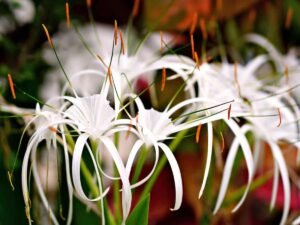Description
Red Spider Lily
:max_bytes(150000):strip_icc()/growing-red-spider-lily-5093664-hero-6e311153f91e4f32b043c76b4f510469.jpg) The red spider lily is a late summer-blooming perennial bulb from the amaryllis family (Amaryllidaceae). Native to China, Japan, Korea, and Nepal, it typically thrives in shady, moist environments along slopes and rocky stream banks. The genus name Lycoris honors a Roman actress and mistress of Mark Antony, while the species epithet radiata is Latin for “spoke,” describing the way the flower tepals spread outward like the spokes of a wheel or radiate from the umbel.
The red spider lily is a late summer-blooming perennial bulb from the amaryllis family (Amaryllidaceae). Native to China, Japan, Korea, and Nepal, it typically thrives in shady, moist environments along slopes and rocky stream banks. The genus name Lycoris honors a Roman actress and mistress of Mark Antony, while the species epithet radiata is Latin for “spoke,” describing the way the flower tepals spread outward like the spokes of a wheel or radiate from the umbel.
Variegated Spider Lily
 This spider lily, botanically known as Hymenocallis littoralis and belonging to the Amaryllidaceae family, is renowned for its striking display of flowers. Commonly referred to as the Peruvian Daffodil, Narrow Leaf Spider Lily, or Beach Spider Lily, this plant is native to India and is celebrated for its exceptional foliage and snow-white blooms. It should not be confused with the Spider Plant (Chlorophytum comosum).
This spider lily, botanically known as Hymenocallis littoralis and belonging to the Amaryllidaceae family, is renowned for its striking display of flowers. Commonly referred to as the Peruvian Daffodil, Narrow Leaf Spider Lily, or Beach Spider Lily, this plant is native to India and is celebrated for its exceptional foliage and snow-white blooms. It should not be confused with the Spider Plant (Chlorophytum comosum).
This clumping, herbaceous perennial grows to a height of 2 to 3 feet, featuring variegated, linear leaves that extend up to 3 feet in length and emerge from an underground bulb. During summer and fall, and throughout the year, it produces clusters of fragrant, long-lasting white flowers. These flowers, characterized by their 6-inch-long tubes and narrow, recurving sepals and petals, often bloom in abundance at the beginning of the rainy season and during subsequent wet periods.
Features:
- One of the hardiest lilies to grow, this variety features striking white flowers with a large central cup and funnel shape, complemented by variegated leaves.
- The sweetly fragrant blooms are also popular for use in garlands.
- These lilies are easy to cultivate, thriving in any type of soil with moderate fertility.
- They are relatively low-maintenance and can become dormant during prolonged dry periods.
- Their nectar-rich, colorful flowers attract butterflies and hummingbirds, particularly during the monsoon and summer seasons.
- These plants can be grown either in pots, directly in the soil, or as border plants in the garden, making them a versatile choice for any landscape.









Reviews
There are no reviews yet.